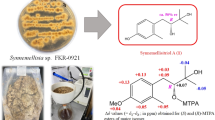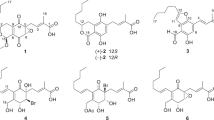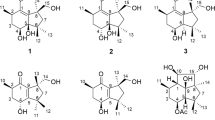Abstract
Two new amides, named N-acetyl-2,4,10,17-tetrahydroxyheptadecylamine (1) and N-acetyl-3,5,11,18-tetrahydroxyoctadecyl-2-amine (2), were isolated from a halotolerant fungus, Myrothecium sp. GS-17. Their structures were identified on the basis of spectroscopic characteristics. The cancer cell cytotoxicities of two compounds were evaluated, and compound 2 exhibited weak cytotoxicity in HL-60 cell line.
Similar content being viewed by others
Introduction
Recent investigations of cultured extreme environmental microbes revealed numerous bioactive natural products.1,2 Diverse secondary metabolites have been isolated from various cultured extreme-tolerant microbes, extremophiles and deep-sea microbes, which exhibited interesting biological activities, such as antitumor, antifungal and antibacterial activity.3, 4, 5, 6
In the course of our ongoing studies of special environmental microorganisms as sources of new bioactive secondary metabolites, a halotolerant fungus Myrothecium sp. GS-17 was isolated from the soil sample of a salina at Gansu province in China. In the preliminary screening of the extracts from liquid fermentation cultures for in vitro activity, the fungal GS-17 was found to produce metabolites with strong growth inhibition activity against human leukemia (HL-60) cell line. Chemical investigation of the extract led to the isolation of two new amide derivatives, N-acetyl-2,4,10,17-tetrahydroxy-heptadecylamine (1) and N-acetyl-3,5,11,18-tetrahydroxyoctadecyl-2-amine (2). By means of spectroscopic analysis (UV, IR, NMR and MS) and physico-chemical properties, their chemical structures were determined respectively. Herein, we describe the isolation, structure elucidation and biological activities of the two compounds.
Results
The extract of fermented broth of Myrothecium sp. GS-17 was fractionated by repeated column chromatography to yield compounds 1 and 2 (Figure 1). Their structures were elucidated on the basis of spectroscopic methods.
Physicochemical properties
N-acetyl-2,4,10,17-tetrahydroxyheptadecylamine (1)
White amorphous powder; mp 143 °C, [α]D20=−11.5 (c 0.13, MeOH); UV (MeOH) λmax (log ɛ) 209 nm (1.67); IR (KBr) νmax 3290, 2922, 2849, 1623 cm−1; ESI-MS m/z 384.3 [M+Na]+, HRESI-MS m/z 384.2730 [M+Na]+ (calcd. for C19H39NaNO5+, 384.2720); EI-MS m/z 228, 146, 128, 102, 73, 43. 1H-NMR (300 MHz, pyridine-d5) and 13C-NMR (150 MHz, pyridine-d5) data are shown in Table 1.
N-acetyl-3,5,11,18-tetrahydroxyoctadecyl-2-amine (2)
White amorphous powder; mp 142 °C, [α]D20=−40 (c 0.13, MeOH); UV (MeOH) λmax (log ɛ) 207 nm (1.56); IR (KBr) νmax 3331, 2924, 2850, 1619 cm−1; ESI-MS m/z 376.1 [M+H]+, HRESI-MS m/z 398.2886 [M+Na]+ (calcd. for C20H41NaNO5+, 398.2877); EI-MS m/z 242, 160, 142, 116, 87, 43. 1H-NMR (300 MHz, pyridine-d5) and 13C-NMR (150 MHz, pyridine-d5) data are shown in Table 1.
Structure determination
Compound 1 was isolated as an amorphous powder, and its molecular formula was determined as C19H39NO5 by HRESI-MS (m/z 384.2730 [M+Na]+, calcd. 384.2720), with one degree of unsaturation (Supplementary Figure S2). The 1H-NMR (300 MHz, pyridine-d5) spectrum (Table 1,Supplementary Figure S5) of 1 displayed signals for one amide proton at δH 8.68 (1H, t, J=5.6 Hz), four hydroxyl protons at δH 6.40 (1H, br s), 5.95 (1H, br s), 5.87 (1H, br s) and 5.59 (1H, br s), three oxymethines at δH 4.66 (1H, m), 4.38 (1H, br s) and 3.81 (1H, m). Inspection of 13C-NMR and the DEPT spectra (Table 1,Supplementary Figures S6 and S7) revealed the existence of 19 carbons including one carbonyl carbon at δC 170.5, three oxymethines at δC 70.9, 68.4, 68.1, one oxymethylene δC 62.1, one nitrogen-bearing sp3 methylene at δC 47.2 and one methyl group at δC 23.1. Six aliphatic methylene signals [δH 1.37–1.78 (12H, m), δC 26.3–30.4] suggested the presence of aliphatic chain. The proton and carbon signals (Table 1) were assigned from the 2D-NMR (1H-1H COSY, HSQC and HMBC).
The 1H-1H COSY spectra (Figure 2 and Supplementary Figure S8) of 1 disclosed two structural units of NH-C1-C2-C3-C4-C5, C2-OH, C4-OH and C16-C17-OH, suggesting the presence of 2,4,17-trihydroxy groups. In the HMBC spectrum (Figure 2 and Supplementary Figure S10), the correlations from N-H (δH 8.68) and methyl protons H-2' (δH 2.07) to a carbonyl carbon C-1' (δC 170.5), and from N-H (δH 8.68) to C-1 (δC 47.2) indicated that C-1 was substituted by an acetylamino group.
The position of the fourth hydroxyl group was determined to be located at C-10 by a significant fragment ion peak at m/z 228 [M−C7H14OH−H2O]+ in EI-MS (Figure 3 and Supplementary Figure S11). Thus, the structure of 1 was determined to be N-acetyl-2,4,10,17-tetrahydroxyheptadecylamine.7
Compound 2 was isolated as an amorphous powder, and its molecular formula was determined as C20H41NO5 by HRESI-MS (m/z 398.2886 [M+Na]+, calcd. 398.2877), with one degree of unsaturation (Supplementary Figure S13). Compared with the NMR data of compound 1, the 1H-, 13C-NMR and DEPT data (Supplementary Figures S16–S18) indicated 2 was an analog of compound 1. Inspection of 13C-NMR (Table 1) and the DEPT spectra of 2 revealed that compound 2 possessed one more methyl than compound 1. The nitrogen-bearing methylene at δC 47.2 of compound 1 was replaced by a nitrogen-bearing methine at δC 50.4. The HMBC correlations (Figure 2 and Supplementary Figure S21) from H-1 to C-2 and C-3 suggested an acetylamino at C-2. 11-Hydroxy group location was determined by a fragment ion peak at m/z 242 [M−C7H14OH−H2O]+ in EI-MS (Figure 3 and Supplementary Figure S22). Thus, the structure of 2 was determined to be N-acetyl-3,5,11,18-tetrahydroxyoctadecyl-2-amine.7
Biological activity
The cancer cell cytotoxicities of compounds 1 and 2 were evaluated. The cytotoxic potential of the isolated compounds was investigated by determining their concentrations required for 50% growth inhibition (IG50 value) for three human cancer cell lines (HL-60, MCF-7, PC-3). Compound 2 shows a weak activity against human leukemia (HL-60) cancer cell with IG50 value of 63.61 μM.
Discussion
Our investigation on the metabolites of the halotolerant fungus Myrothecium sp. GS-17 has resulted in the isolation of two new amides, N-acetyl-2,4,10,17-tetrahydroxyheptadecylamine (1) and N-acetyl-3,5,11,18-tetrahydroxyoctadecyl-2-amine (2). Compound 2 shows a weak activity against HL-60 cancer cells. The notable growth inhibition activity of the original extract against HL-60 cell line could be attributed to the presence of trichothecenes, which was reported to show various remarkable cytotoxic activities.8 Compound 2 has one more methyl than 1, which increased the cytotoxic activity against human leukemia (HL-60) cancer cell in this kind of amide structure. These two compounds belong to ceramide (or sphingolipid) analogs, which are a family of important lipid in skin, hair and nail of human and animal’s brain.9,10 In addition, people found that ceramides have relatively potent antitumor activity.11
Methods
General experimental procedures
The UV spectra were conducted on a UV-2201 spectrometer (Shimadzu, Kyoto, Japan). The FT-IR spectra were obtained on a Bruker IFS-55 spectrometer (Bruker, Ettlingen, Germany) by a KBr disk method. ESI-MS spectra were conducted on an Agilent 1100 ion trap spectrometer (Agilent Technologies, Palo Alto, CA, USA). HRESI-MS was recorded on a QFT-ESI mass spectrometer (Varian, Palo Alto, CA, USA). 1H-NMR and 13C-NMR spectra were recorded on Bruker ARX-300 and AV-600 NMR spectrometers (Bruker, Ettlingen, Germany) using pyridine-d5 as an internal standard [δH/C 7.20, 7.57, 8.72/123.44, 135.43, 149.84 (C5D5N)]. Optical rotations were measured with a Perkin-Elmer 241 polarimeter (Perkin-Elmer, Boston, MA, USA). The chromatographic silica gel (200−300 mesh) was purchased from Qingdao Ocean Chemical Factory (Qingdao, China) and ODS (50 μm) was purchased from YMC Co. Ltd, Kyoto, Japan. Sephadex LH-20 was purchased from GE Healthcare, Uppsala, Sweden. RP-HPLC analysis and semi-preparation were conducted using HITACHI L2130 series pumping system equipped with a HITACHI L2400 UV detector (Tokyo, Japan) and performed with a C-18 column (10 × 250 mm, 10 μm; YMC Co. Ltd, Kyoto, Japan).
Strain
The halotolerant fungal strain GS-17 was separated by dilution isolation method from the soil sample of a salina at Gansu province. The fungus was identified as Myrothecium sp. on the basis of morphological and blast search of ITS sequence using the Genbank database. The morphology of the strain GS-17 displays that the colonies are white, ball and flocculent with black oil secretions on the surface. The sizes of strains are 0.5–2.5 μm × 6–10 μm, and they are round and opaque with irregular edge and surface projection. In addition, colonies are beige granules in liquid nutrient medium. ITS sequence of strain GS-17 showed 100% homology with those of Myrothecium verrucaria (GenBank accession number HQ625520) and Myrothecium atroviride (GenBank accession number AJ302002; Supplementary Figure S23). The voucher specimen was deposited in Department of Natural Products Chemistry, Shenyang Pharmaceutical University, China. The initial cultures were maintained on the potato dextrose agar (PDA) plate.
Fermentation
A small loop of spores growing on a PDA slant was inoculated into a 250 ml Erlenmeyer flask containing 75 ml sea-water-based culture medium (maltose 2%, monosodium glutamate 1%, KH2PO4 0.05%, MgSO4·7H2O 0.03%, glucose 1%, yeast extract 0.3%, corn steep liquor 0.1%, mannitol 2%, sea water, pH 6.5) and cultured at 28 °C for 2 days on a rotary shaker at 180 rotations per minute. Then, 10 ml of the resultant seed culture was inoculated into a 500 ml Erlenmeyer flask containing 150 ml of the above culture medium and incubated (500 flasks) for 8 days at the same conditions.
Extraction and isolation
The fermented broth (56 l) was filtered through cheese cloth to yield the supernatant and mycelia. The supernatant was subjected to HPD100 macroporous absorption resin, eluted in gradient with EtOH/H2O 30%, 70%, 100% to yield three fractions (1–3). Fraction 2 was fractioned on a silica gel column eluting with CH2Cl2−MeOH (from 100:0 to 0:100) and was further separated by a flash silica gel column (eluted with petroleum ether/acetone, 10:1) to give three subfractions (A–C). Subfraction A was further purified by RP-HPLC [MeCN/H2O (65%), 2.0 ml min−1] to yield 1 (10.0 mg) and 2 (6.0 mg).
In vitro cytotoxic assay
The in vitro cell growth inhibition activities of crude extracts and the isolated compounds in human promyelocytic leukemia HL-60 cell lines were evaluated by the Trypan blue method. In addition, the cell growth inhibition activities of compounds were assayed by the Trypan blue method using human breast adenocarcinoma MCF-7 cell line, and the MTT method using human prostate cancer PC-3 cell line as previously described.12,13 The cell lines obtained from American Type Culture Collection, Rockville, MD, USA were cultured in RPMI-1640 medium (Gibco, New York, NY, USA) supplemented with 100 U ml−1 penicillin, 100 μg ml−1 streptomycin, 1 mmol glutamine and 10% heat-inactivated fetal bovine serum.
Accession codes
References
Ding Z. G. et al. Naphthospironone A: an unprecedented and highly functionalized polycyclic metabolite from an alkaline mine waste extremophile. Chem. Eur. J. 16, 3902–3905 (2010).
Wilson Z. E., Brimble M. A. Molecules derived from the extremes of life. Nat. Prod. Rep. 26, 44–71 (2009).
Pettit R. K. Culturability and secondary metabolite diversity of extreme microbes: expanding contribution of deep sea and deep-sea vent microbes to natural product discovery. Mar. Biotechnol. 13, 1–11 (2011).
Chen L. et al. A new cytotoxic metabolite from a deep sea derived fungus, Phialocephala sp. Yao. Xue. Xue. Bao. 45, 1275–1278 (2010).
Yonezawa K., Yamada K., Kouno I. New diketopiperazine derivatives isolated from sea urchin-derived bacillus sp. Chem. Pharm. Bull. (Tokyo) 59, 106–108 (2011).
Rhee K. H. Cyclic dipeptides exhibit synergistic, broad spectrum antimicrobial effects and have anti-mutagenic properties. Int. J. Antimicrob. Agents 24, 423–427 (2004).
Yang G. et al. Flavusides A and B, antibacterial cerebrosides from the marine-derived fungus Aspergillus Flavus. Chem. Pharm. Bull. (Tokyo) 59, 1174–1177 (2011).
Namikoshi M. et al. A new macrocyclic trichothecene, 12,13-deoxyroridin E, produced by the marine-derived fungus Myrothecium roridum collected in Palau. J. Nat. Prod. 64, 396–398 (2001).
Školová B. et al. The role of the trans double bond in skin barrier sphingolipids: permeability and infrared spectroscopic study of model ceramide and dihydroceramide membranes. Langmuir 30, 5527–5535 (2014).
Kulmacz R.J., Kisic A., Schroepfer G.J. Jr. Sphingolipid base metabolism. Chemical syntheses and properties of N-acetyl derivatives of 4R-, 4S-, 5R-, and 5S-hydroxysphinganine. Chem. Phys. Lipids 23, 291–319 (1979).
Liu J.W., Beckman B.S., Foroozesh M. A review of ceramide analogs as potential anticancer agents. Future Med. Chem. 5, 1405–1421 (2013).
Wang F., Hua H.M., Pei Y.H., Chen D., Jing Y.K. Triterpenoids from the resin of Styrax tonkinensis and their antiproliferative and differentiation effects in human leukemia HL-60 cells. J. Nat. Prod. 69, 807–810 (2006).
Mosmann T. Rapid colorimetric assay for cellular growth and survival: application to proliferation and cytotoxicity assays. J. Immunol. Methods 65, 55–63 (1983).
Acknowledgements
This project was supported by the National Natural Science Foundation of China (Grant No. 20872094).
Author information
Authors and Affiliations
Corresponding author
Ethics declarations
Competing interests
The authors declare no conflict of interest.
Additional information
Supplementary Information accompanies the paper on The Journal of Antibiotics website
Supplementary information
Rights and permissions
This work is licensed under a Creative Commons Attribution-NonCommercial-ShareAlike 3.0 Unported License. The images or other third party material in this article are included in the article’s Creative Commons license, unless indicated otherwise in the credit line; if the material is not included under the Creative Commons license, users will need to obtain permission from the license holder to reproduce the material. To view a copy of this license, visit http://creativecommons.org/licenses/by-nc-sa/3.0/
About this article
Cite this article
Liu, T., Zhang, S., Zhu, J. et al. Two new amides from a halotolerant fungus, Myrothecium sp. GS-17. J Antibiot 68, 267–270 (2015). https://doi.org/10.1038/ja.2014.136
Received:
Revised:
Accepted:
Published:
Issue Date:
DOI: https://doi.org/10.1038/ja.2014.136
This article is cited by
-
Fungi from the extremes of life: an untapped treasure for bioactive compounds
Applied Microbiology and Biotechnology (2020)
-
Fungi in salterns
Journal of Microbiology (2019)






